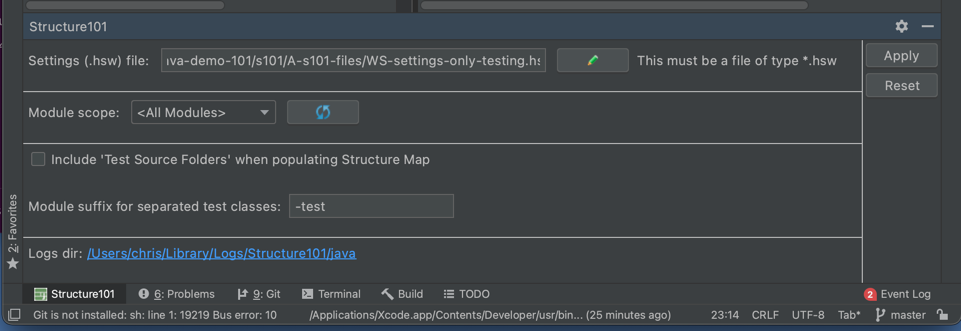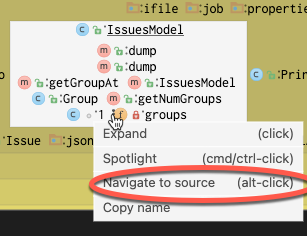When your team works with common IDE/editors such as IntelliJ IDEA or Eclipse, there are advantages to using the "Structure101 Connector" IDE plugin.
The plugin lets Studio and Workspace present models that are tightly aligned with the project structure as seen inside your IDE
It also enables instant 2-way navigation between the Structure Map in Workspace and the source code in your IDE/editor, and gives Workspace and Studio users fine-grained information about structural changes or problems that are caused by local code edits (before commit).
The plugin works by exporting information about the IDE environment (like modules, module dependencies, bytecode locations, etc.) every time an IDE build occurs. It places this information in a "settings file" (*.hsw) that Workspace and Studio can consume.
The plugin also facilitates the 2-way navigation between Workspace and your IDE.
To install, download and install Workspace and the "Structure101 Connector" plugin specific to your IDE/Editor.
With the plugin installed, information about your source/build environment are saved to a "settings" file by the plugin, every time you compile code. You can set the location of this file within the Structure101 properties page in your IDE/editor - for instance this is what it looks like in IntelliJ IDEA:

Set the location/name of the settings file (at first it will be a nonexistent file, created when you next build your project).
This settings file is what you should also specify when you create a project in Structure101 Studio. You can then open either the Studio project (*.hsp), or the settings file (*.hsw) in Workspace.
Once you have your IDE/editor running (with the plugin installed), and the same projects open in both Workspace and the IDE/editor, you can tell Workspace to connect to it for navigation. To do this, click the "Connect to Source Editor" (the red link icon) button in Workspace:
The link button will turn "green" to indicate success:
Once the link is established, you can navigate from any item in the Workspace Structure Map to the source in the IDE using the context menu (mouse-over the item and click on the 3 vertical dots that appear to the left of the item's icon). The context menu also shows the shortcut action (e.g. alt-click to 'navigate to source'):

The file should open with the cursor at the first line of the corresponding source in your IDE/editor.
The Structure101 Connector plugin adds a command to your editor's context menu to navigate from source to Structure Map - right-click to bring up the context menu with the "Show in Structure Map" option. In general you should be able to navigate from anywhere in the source of an item (e.g. a method) but this can vary between IDE/editors/languages- for instance it may be sensitive to what is selected in the source).
When working in Workspace with a Studio project file (*.hsp), or a Connector settings file (*.hsw), you can work get fine-grained information about structural changes as you edit source code.